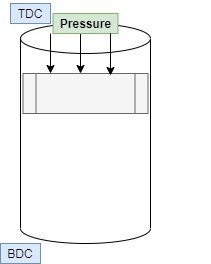Content
- Quasi-static process definition
- Non quasi-static process
- Difference between quasi-static and reversible process
- Example of quasi-static process
- Characteristics of quasi-static process
- Common quasistatic processes
- Condition for an ideal gas in a quasistatic adiabatic process
- Conditions for quasi-static process
- Difference between quasi-static and non quasi-static process
- Heat transferred in an infinitesimal quasi-static process
- Importance of quasi-static process
- Non quasi-static process example
- Non-quasi-static cyclic process
- Quasi-static process diagram
- Quasi-static process entropy
- Quasi-static process equation
FAQ/Short Notes
- What is a quasi static force ?
- Is reversible process quasi static ?
- Is adiabatic process quasi static ?
- What are the examples of Quasistatic processes in our daily lives ?
- Why a reversible process is necessarily a Quasi static process ?
- Since the pressure is uniform in the quasi static process, how can there be any work done?
Quasi-static process definition
It can be defined in simple words process happening very slowly, and all state passed by this process is in equilibrium.
The meaning of the word “Quasi” is almost. The static means the thermal properties are constant concerning time. All the reversible processes are quasi. The slow rate of the process is the main characteristic of the this process.
Non quasi-static process
It is not realized for any finite difference of the system. Most of the processes happening around us (in nature) can be termed as non quasi-static process.
Both of the process can be well understood by diagram as shown below,

It helps analyze. It is primarily studied in books and references. We already know the introductory study of thermodynamic starts with quasi processes. We can readily notice work PdV in this diagram. The curve of non quasi looks half-circle type. The quasi-static method is represented by a straight line.
Difference between quasi-static and reversible process
We can define a reversible process as if the system restores its initial or starting stage and there is no effect of the process on the surrounding.
In a reversible process, the process follows the same path in the forward and reverse functions. There is no impact of the system on the surrounding. Ideally, this type of process can not be possible due to friction.
It can be defined in simple words process happening very slowly, and all state passed by this process is in equilibrium.
There is no friction present in this process. So, we can say that ideally, the processes are reversible.
There is no entropy generation in both processes. We can make any process reversible if we continue the process at a prolonged rate.
Example of quasi-static process
We can consider the static compression process as an example of the quasi-static process. In this process, the system’s volume will change very slowly, but the pressure of the system remains throughout the process.
Compression process with cylinder and piston is shown in figure below,

Characteristics of quasi-static process
It is a thermodynamic process where the process occurs at a very slow rate. We can say the process occurs at near to rest condition.
Every point or stage in the this process is considered in equilibrium conditions.
We can say that control on the quasi process is effortless. In the non quasi-static process, the control can be challenging compared to ideal quasi. The reason behind it is the speed of the process.
It is a thermodynamic process in which the time taken for the complete process will be infinite.
It is highly efficient as there is no loss in this process. There is no friction or heat generation due to friction. In the case of a non quasi process, friction is present, which is ultimately loss so less efficient than quasi.
This process is reversible in nature.
Device working on quasi-static process produce maximum work
Common quasistatic processes
Ideally, the quasi reversible process can not possible practically. There is always some loss in any system. With some assumptions, we can consider some processes as quasi processes.
- Ideal Gas processes at a slow rate.
- Compression process at a prolonged rate
- Reversible Processes.
- Growth of tree
Huge Temperature Reservoir
Condition for an ideal gas in a quasi-static adiabatic process
If we consider the quasi adiabatic process, there is some condition to be satisfied. If ideal gas is compressed from state 1 to state 2, then
P1 and V1 Is the initial condition of the system,
P2 and V2 Is the final condition of the system,
The condition for the system is,
![]()
We can write this condition for both condition as below,
![]()
Conditions for quasi-static process
It is a thermodynamic process where the process occurs at a very slow rate. We can say the process occurs at near to rest condition.
Every point or stage in this process is considered in equilibrium conditions.
We can say that control on this process is very easy. In the non quasi-static process, the control can be challenging compared to quasi. The reason behind it is the speed of the process.
It is a thermodynamic process in which the time taken for the complete process will be infinite.
This process is highly efficient as there is no loss. There is no friction or heat generation due to friction. In the case of a non quasi process, friction is present, which is ultimately loss so less efficient than quasi.
This process is reversible in nature.
Device working on this process produce maximum work
Difference between quasi-static and non quasi-static process
It can be defined in simple words that it is the process happening very slowly, and all state passed by this process is in equilibrium.
This process is always reversible in nature.
There is no friction or loss present.
It is not realized for any finite difference of the system. Most of the processes around us (in nature) can be termed a non quasi-static process.
The non quasi process is always irreversible.
There is always friction and loss present in the system.
We can write relation for entropy generation,
![]()
Where dS denotes entropy change in system
The entropy change in the system can be positive, negative, or zero.
Heat transferred in an infinitesimal quasi-static process
Heat transfer equation for this ideal process can be written in following foam for calculation,

Here
dQ = Heat transfer
Cv= Constant volume heat capacity
n= no. of moles of substance
R= ideal gas constant
Cp= Constant pressure heat capacity
V = volume,
dV = Differential volume
P= Pressure,
dP = Differential pressure
Importance of quasi-static process
It is proposed in 1909 as a ” quasi-static process.” It is an essential process in the field of thermodynamic for analysis. It is providing maximum output work in the system. Though this process is ideal, this process in the various study is vast.
In this process, the system remains in equilibrium for infinitesimal time. The reasons behind its importance in the field of engineering are
1. This process is easy for analysis
2. Any device working on this process produces maximum work. There is no loss of any energy.
Non quasi-static process example
Every process in nature is a non quasi-static process,
Those processes do not occur at a prolonged rate. You can consider any processes non quasi-static process.
- Fast Heat transfer,
- Fast compression,
- Expansion,
Non-quasi-static cyclic process
It is not realized for any finite difference of the system. Most of the processes around us (in nature) can be termed a non quasi-static process.
We can readily notice the curve in the diagram given below. As we know, the non quasi-static process does not return with the same path. The backward process is always with a different direction to be considered a cyclic process.
Quasi-static process diagram
The diagram for both of the process shown below for the expansion process.

Quasi-static process entropy
We can write relation for entropy generation,
![]()
Where dS denotes entropy change in system
The entropy change in the system can be positive, negative, or zero.
Quasi-static process equation
It can be derived for various processes in thermodynamics. The equation for different process with the constant property is given below,
Process with Constant pressure (Isobaric process)
![]()
Process with Constant volume (Isochoric process)
![]()
Process with Constant temperature (Isothermal processe)

![]()
FAQs
What is quasi static force ?
It can be stated as the force applied very slowly on the system. Due to this force, the system deforms very slowly with infinite time. This type of force can be defined as a quasi-static force.
Is reversible process quasi static?
This process is always reversible.
There is no friction or loss present.
It is not realized process for any finite difference of the system. Most of the processes around us (in nature) can be termed a non quasi-static process.
Is adiabatic process quasi static ?
An adiabatic process is a process with no heat transfer. It is also considered as an isentropic process means constant entropy of the system.
There are some conditions of the process to be quasi.
If the adiabatic process occurring at a very slow rate, then it can be considered as quasistatic adiabatic process
What are the examples of Quasi static processes in our daily lives?
It is an ideal process in nature; still, the process that occurs very slowly can be considered as quasi.
Growth of tree,
Why a reversible process is necessarily a Quasi static process?
This process is always reversible in nature.
There is no friction or loss present. There is no heat loss at all in this process
It is not realized for any finite difference of the system. Most of the processes around us (in nature) can be termed a non quasi-static process.
Since the pressure is uniform in the quasi static process, how can there be any work done ?
If the pressure is constant in any system with the this process, the work done can be given by the following equation,
Process with Constant pressure (Isobaric process)
![]()

I am Deepak Kumar Jani, Pursuing PhD in Mechanical- Renewable energy. I have five years of teaching and two-year research experience. My subject area of interest are thermal engineering, automobile engineering, Mechanical measurement, Engineering Drawing, Fluid mechanics etc. I have filed a patent on “Hybridization of green energy for power production”. I have published 17 research papers and two books.
I am glad to be part of Lambdageeks and would like to present some of my expertise in a simplistic way with the readers.
Apart from academics and research, I like wandering in nature, capturing nature and creating awareness about nature among people.
Also refer my You-tube Channel regarding “Invitation from Nature”